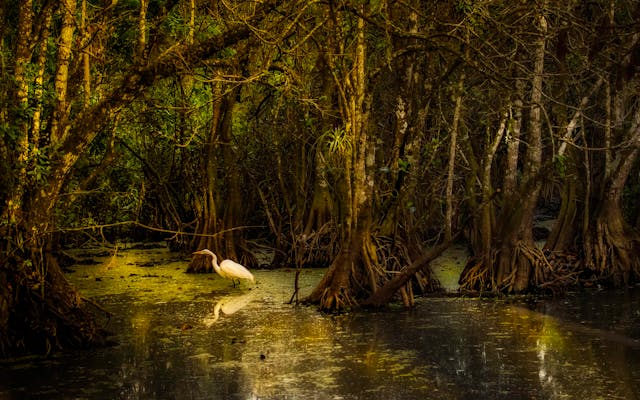
How do mangrove trees live in saltwater? Mangrove trees are able to live in saltwater because they have a way of removing the salt from the water. Because of this, they are usually found in seawater, or very salty still water.
There are a lot of organisms that can survive in salt water and a lot that can’t. We obviously can’t. If we drink salty water, our kidneys need to get rid of it. We need salt to function. We use salt to dissolve proteins, use our muscles, pump blood, and even for our brains. However, the balance of salt in our bodies is strictly controlled. If the salt levels go too high, water gets pulled out of our cells, making them shrink. The kidneys also have to use a lot of water to flush the salt out of the body and we end up urinating out far more water than we take in. If you have only eaten salty food, then you can drink some water to reset the balance. If you are on a boat in the ocean and you are only drinking seawater, you will die fairly quickly. Fish get around this by having specialized cells and kidneys that help them remove the salt and by constantly drinking water. This enables them to keep their salt levels stable.
Mangroves are not a single tree and there are seventy different species of mangrove altogether. They all differ in where they live and how they develop, but they all grow in areas that would kill most organisms. They grow on coasts and shorelines which mean they have had to adapt to a wide range of conditions. They obviously need to be able to survive the salty conditions. If they couldn’t deal with the salt, they would be desiccated pretty quickly. They need to be able to cling on to unstable and sifting coasts and floors. They need to survive the waves and the tides. They need to be able to survive low oxygen caused by the mud that gets mixed up by the waves.
So, how do mangroves manage to survive in such difficult conditions? Let’s look at salt first. Some mangroves live in slightly salty water, some live in seawater, which is about 4% salt, and some live in saltier waters created by evaporation, such as the Dead Sea, which can be 9% salt. Mangroves have two ways of dealing with the salt. They can either let the salt in and then get rid of it, or they can stop it from coming in.
A minority of mangrove species use a nonpermeable barrier to block the salt from coming it. It lets through only the water and about 10% of the salt, which is enough for the plant to cope with. The majority of mangroves remove the salt once they have taken it in through their roots. They push the salty water up to their leaves. Once there, there are two methods to get the salt out. In the first method, the salt, with some of the water, exits out of small pores called stomata. The water evaporates, leaving salt crystals on the leaf. In the second method, more and more salty water is pushed up to the leaves and stored there. Leaves have big cells and they can hold a lot of water. Once the leaves get old, they drop off, taking the salt with them.
Mangroves managed to stay upright in the soft soil at the coast by using a variety of different roots. They have long roots that go down and to the side, but they also use a large number of roots that support them. These are called stilt roots and they spread away from the trunk, providing a support that often keeps the trunk of the tree above the water. As the tides come and go, it might look like the tree is standing on stilts. These support roots also help hold the tree up against the waves and the tides.
Mangrove trees usually grow in water that doesn7t have much oxygen. Trees need oxygen in order to photosynthesize. Most trees take in oxygen through their roots, but mangroves aren’t able to do that because their roots are underwater. They have adapted by either growing part of their roots straight up above the ground, to keep them above the water line. Or they have holes in their trunk that can take in oxygen.
Mangroves are very versatile trees, but they do a lot to hold the coastline together and they are a good defense against erosion. They also provide a habitat for a lot of different animals. And this is what I learned today.
Try these’
Sources
https://www.amnh.org/explore/videos/biodiversity/mangroves/what-is-a-mangrove
https://ocean.si.edu/ocean-life/plants-algae/mangroves
https://en.wikipedia.org/wiki/Mangrove
https://science.howstuffworks.com/science-vs-myth/what-if/what-if-you-drink-saltwater.htm
Photo by Ray Bilcliff: https://www.pexels.com/photo/a-white-egret-in-a-swamp-7323180/
